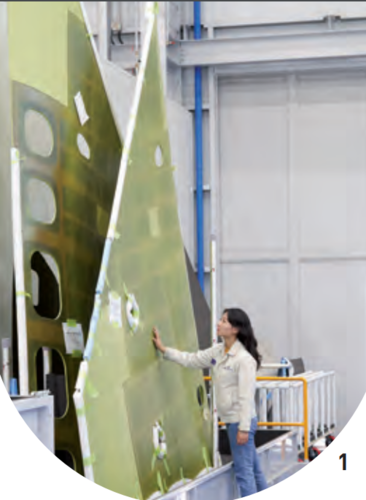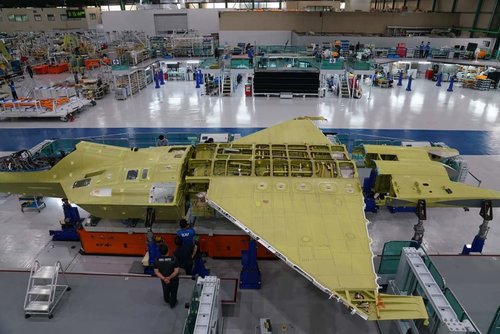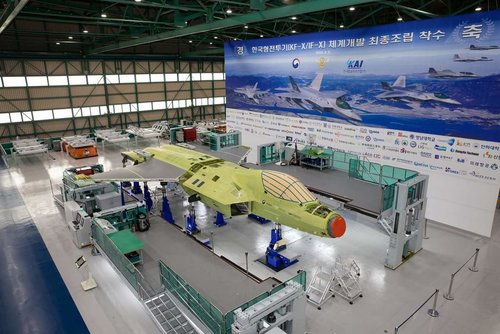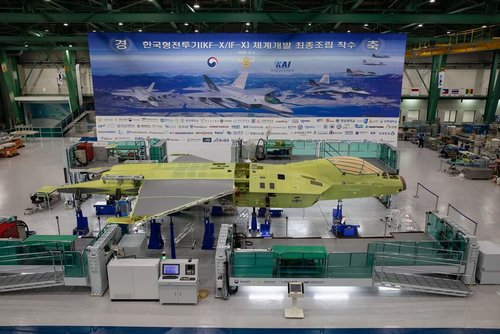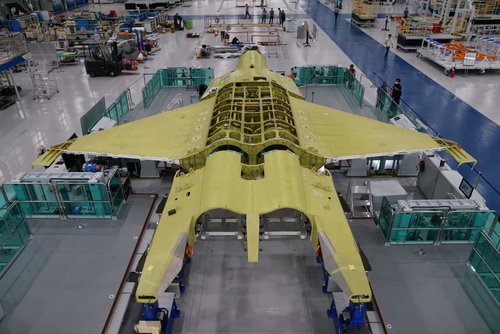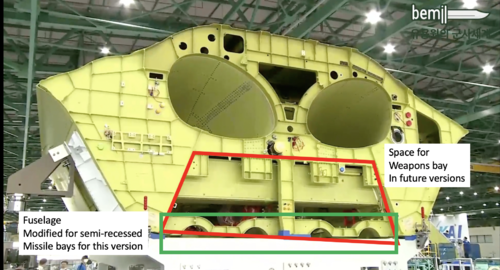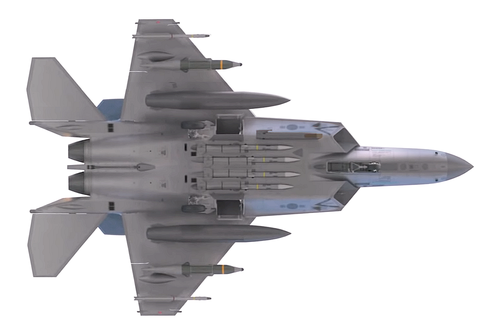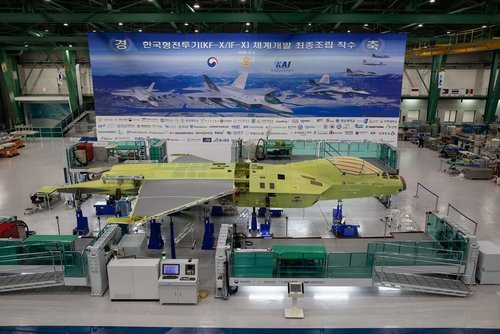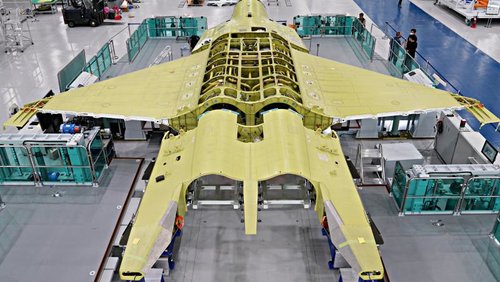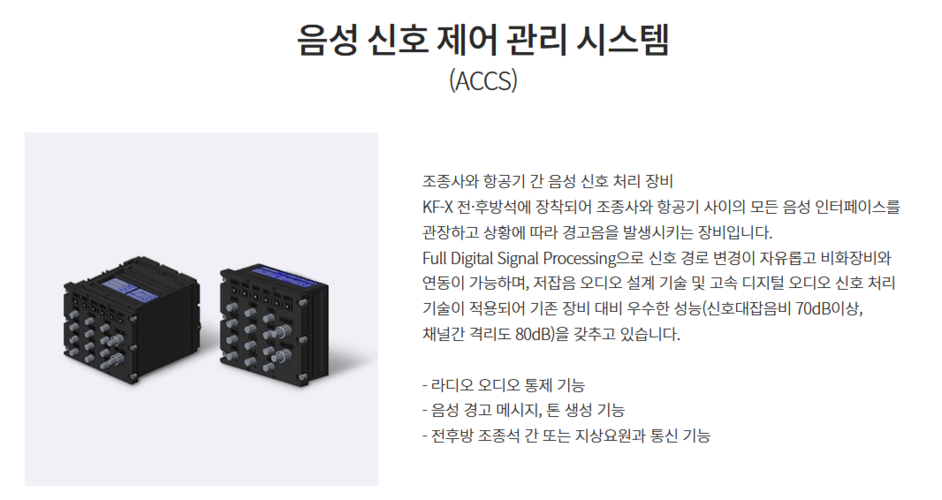You are using an out of date browser. It may not display this or other websites correctly.
You should upgrade or use an alternative browser.
You should upgrade or use an alternative browser.
KAI KF-21 Boramae (KFX Korean Indigenous Fighter program)
Frogfigther
ACCESS: Restricted
- Joined
- 30 August 2020
- Messages
- 45
- Reaction score
- 169
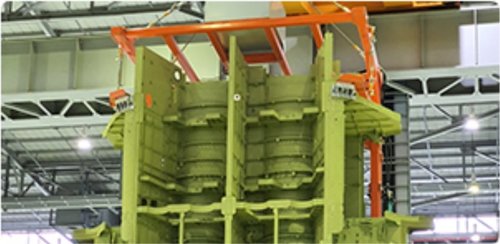
Central fuselage for KF-X Prototype.
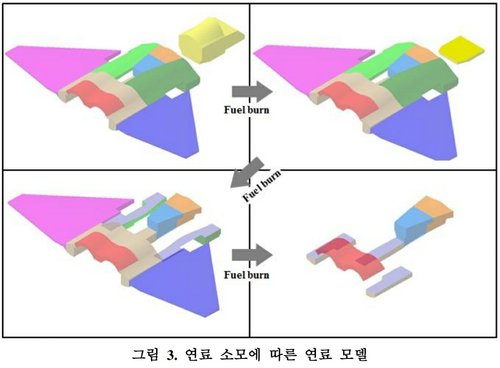
Internal fuel tank model.
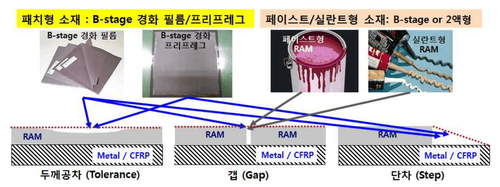
Film style RAM(similar to RAM applied to F-35).
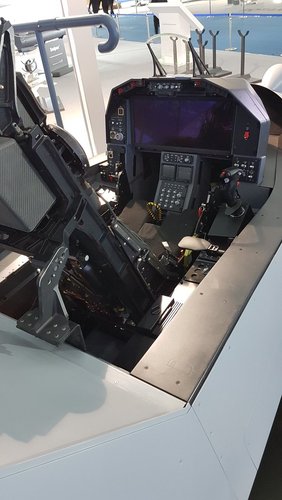
1:1 scale cockpit model.
Source
KF-X RAM/CFRP 일체형 복합재 - 군사 갤러리
① 동체 일체성형용 B-stage 경화 프리프레그형 흡수소재차세대 한국형 전투기 동체소재인 CFRP(탄소섬유복합재) 프리프레그와 유사 에폭시 수지를 적용하여 CFRP 동체와 일체성형이 가능한 형태의 제품 개발. 도료
https://m.blog.naver.com/jhst3103/222058914795
Last edited:
Frogfigther
ACCESS: Restricted
- Joined
- 30 August 2020
- Messages
- 45
- Reaction score
- 169
- Joined
- 29 November 2010
- Messages
- 1,772
- Reaction score
- 3,469
great, thanks for all the pics and update even if they are in the Korean language.
the KFX really excites me. Not so much because its cutting edge..
but because its a new entry into a mid-weight fighter market that has been traditionally dominated by the US, Western Europe, Russia, and the PRC.
especially because its a stealth jet (well semi-stealth for now until they get the funding for the full stealth version)
the KFX really excites me. Not so much because its cutting edge..
but because its a new entry into a mid-weight fighter market that has been traditionally dominated by the US, Western Europe, Russia, and the PRC.
especially because its a stealth jet (well semi-stealth for now until they get the funding for the full stealth version)
- Joined
- 11 February 2010
- Messages
- 1,641
- Reaction score
- 2,678
All that remains now is hope that Indonesia does not reduce the amount of purchase as it would considerably affect the price of each aircraft.
I did a little lookup on possible KFX cost. I'm using modified DAPCA84 (Gonna update it to whatever latest version i could get soon)
Production run of 200 aircrafts + 6 prototypes would amount to about 16.2 B USD (FY2020, RDTE+ Flyaway cost) Which make each plane cost about 97 M USD. Additional 50 aircrafts however would allow 64 M USD Price.
If Indonesia ever cancel or reduce the amount of purchase, the plane would end up having about 109 M USD of cost. Which might not be the best interest for Korea.
I did a little lookup on possible KFX cost. I'm using modified DAPCA84 (Gonna update it to whatever latest version i could get soon)
Production run of 200 aircrafts + 6 prototypes would amount to about 16.2 B USD (FY2020, RDTE+ Flyaway cost) Which make each plane cost about 97 M USD. Additional 50 aircrafts however would allow 64 M USD Price.
If Indonesia ever cancel or reduce the amount of purchase, the plane would end up having about 109 M USD of cost. Which might not be the best interest for Korea.
Frogfigther
ACCESS: Restricted
- Joined
- 30 August 2020
- Messages
- 45
- Reaction score
- 169

대한민국 차세대 전투기, KF-21 보라매
한국형 차세대 전투기(Korean Fighter eXperimental, KF-X) 개발사업은 `15년부터 `28년까...
 m.blog.naver.com
m.blog.naver.com
I recommend reading the article above to understand overall engineering features using website translator, i.e. google chrome translator.

대한민국 차세대 전투기, KF-21 보라매
한국형 차세대 전투기(Korean Fighter eXperimental, KF-X) 개발사업은 `15년부터 `28년까...m.blog.naver.com
I recommend reading the article above to understand overall engineering features using website translator, i.e. google chrome translator.
WOW! Thanks.
- Joined
- 11 February 2010
- Messages
- 1,641
- Reaction score
- 2,678
Ok. Guess this is it. Not as finished as i think it would be. But as seen, the shape is clear, the AESA is installed.
Oh and Video of assembling process too.
 www.facebook.com
www.facebook.com
Oh and Video of assembling process too.
Log into Facebook
Log into Facebook to start sharing and connecting with your friends, family, and people you know.
 www.facebook.com
www.facebook.com
Attachments
Last edited:
Frogfigther
ACCESS: Restricted
- Joined
- 30 August 2020
- Messages
- 45
- Reaction score
- 169
Attachments
-
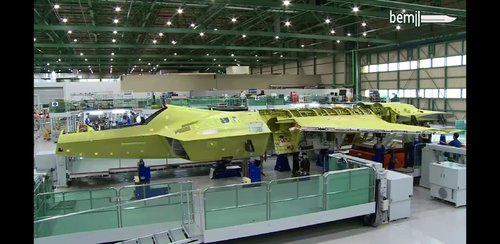 war-20200903-101531-016.jpg1 MB · Views: 153
war-20200903-101531-016.jpg1 MB · Views: 153 -
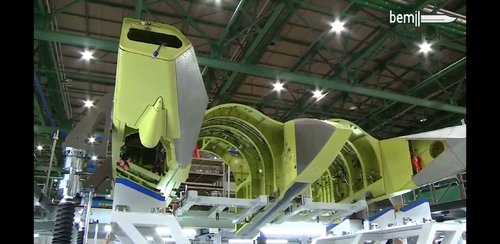 war-20200903-101529-015.jpg1,000.4 KB · Views: 147
war-20200903-101529-015.jpg1,000.4 KB · Views: 147 -
 war-20200903-101528-014.jpg1 MB · Views: 139
war-20200903-101528-014.jpg1 MB · Views: 139 -
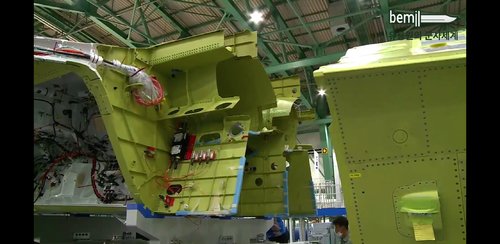 war-20200903-101526-013.jpg962.9 KB · Views: 140
war-20200903-101526-013.jpg962.9 KB · Views: 140 -
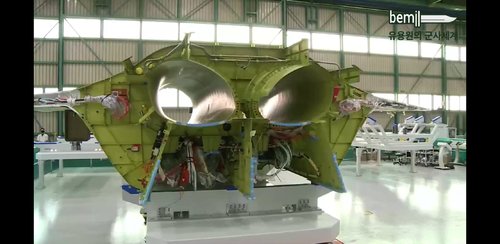 war-20200903-101525-012.jpg839.1 KB · Views: 146
war-20200903-101525-012.jpg839.1 KB · Views: 146 -
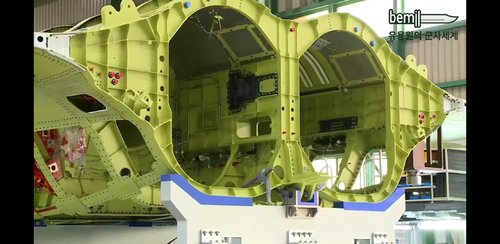 war-20200903-101506-011.jpg940.7 KB · Views: 149
war-20200903-101506-011.jpg940.7 KB · Views: 149 -
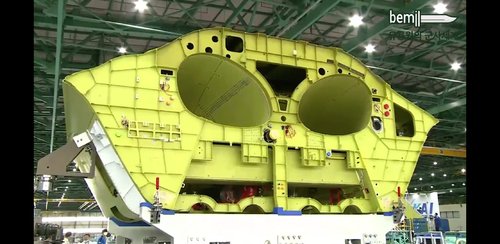 war-20200903-101505-010.jpg1 MB · Views: 152
war-20200903-101505-010.jpg1 MB · Views: 152 -
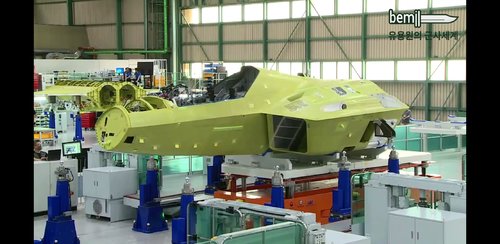 war-20200903-101503-009.jpg1 MB · Views: 148
war-20200903-101503-009.jpg1 MB · Views: 148 -
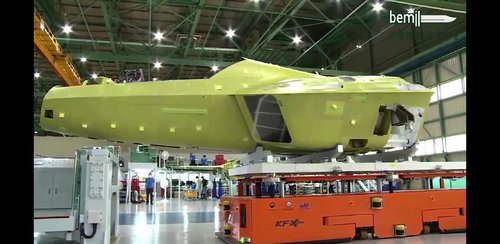 war-20200903-101502-008.jpg962.4 KB · Views: 141
war-20200903-101502-008.jpg962.4 KB · Views: 141 -
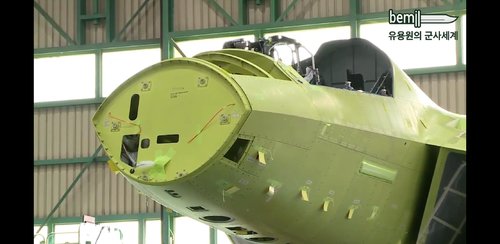 war-20200903-101500-007.jpg754.9 KB · Views: 142
war-20200903-101500-007.jpg754.9 KB · Views: 142 -
 war-20200903-101456-005.jpg951.4 KB · Views: 145
war-20200903-101456-005.jpg951.4 KB · Views: 145 -
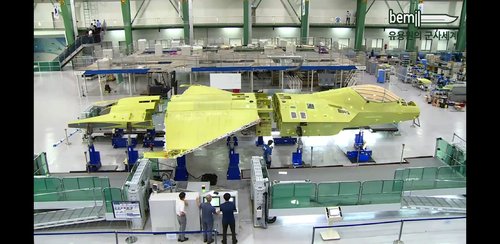 war-20200903-101453-004.jpg1.2 MB · Views: 134
war-20200903-101453-004.jpg1.2 MB · Views: 134 -
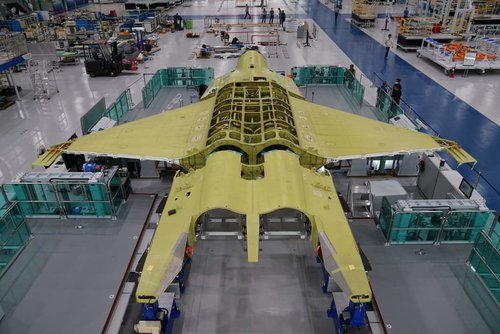 fx4.jpg90.6 KB · Views: 140
fx4.jpg90.6 KB · Views: 140 -
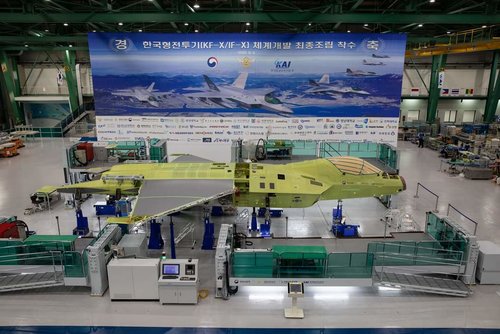 fx1.jpg100.8 KB · Views: 142
fx1.jpg100.8 KB · Views: 142 -
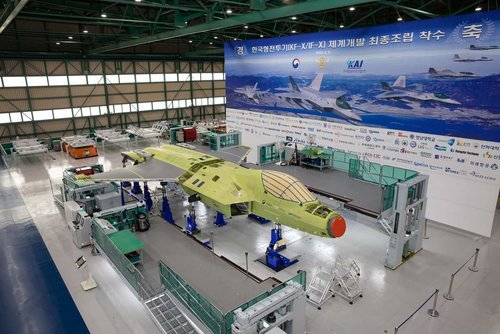 fx2.jpg104.2 KB · Views: 177
fx2.jpg104.2 KB · Views: 177
@Frogfigther : The second video is awesome. Nice find. Top notch workshop also.
Last edited:
- Joined
- 29 November 2010
- Messages
- 1,772
- Reaction score
- 3,469
awesome pics! in the second row left pic, you can see the provisions for a future weapons bay, but being covered by the semi recessed panel
- Joined
- 29 November 2010
- Messages
- 1,772
- Reaction score
- 3,469
- Joined
- 11 February 2010
- Messages
- 1,641
- Reaction score
- 2,678
View attachment 640573
modified froggy's pic to better explain
my question is.. in the future, can the semi-recessed bay version be modified to use the full bay in the future?
The answer is yes... it's just something far ahead in the future. Once the first batch operational KFX enters service and operational experience gained
Frogfigther
ACCESS: Restricted
- Joined
- 30 August 2020
- Messages
- 45
- Reaction score
- 169
Bhurki
ACCESS: Secret
- Joined
- 16 July 2020
- Messages
- 345
- Reaction score
- 382
That rectangular block that covers the volume for the supposed weapons bay might be an additional fuel tank.View attachment 640573
modified froggy's pic to better explain
my question is.. in the future, can the semi-recessed bay version be modified to use the full bay in the future?
So in the future there might be 2 versions -
One long legged version with shown configuration of semi recessed A-A points, and another shorter legged version with internal bay used for A-G/A munition.
That rectangular block that covers the volume for the supposed weapons bay might be an additional fuel tank.View attachment 640573
modified froggy's pic to better explain
my question is.. in the future, can the semi-recessed bay version be modified to use the full bay in the future?
So in the future there might be 2 versions -
One long legged version with shownconfiguration of semi recessed A-A points, and another shorter legged version with internal bay used for A-G/A munition.
It's known as the ammunition storage for the 20mm vulcan. Currently more than 300 rounds could be loaded so even when the IWB is installed, I guess around healthy 150 or so rounds could be loaded.
My friend, I think it will be sold well in the middle east to countries like the UAE which have very good relations with South Korea to replace Mirage 2000 and Block 60 in 10-15 years possibly and complement F-35.All that remains now is hope that Indonesia does not reduce the amount of purchase as it would considerably affect the price of each aircraft.
I did a little lookup on possible KFX cost. I'm using modified DAPCA84 (Gonna update it to whatever latest version i could get soon)
Production run of 200 aircrafts + 6 prototypes would amount to about 16.2 B USD (FY2020, RDTE+ Flyaway cost) Which make each plane cost about 97 M USD. Additional 50 aircrafts however would allow 64 M USD Price.
If Indonesia ever cancel or reduce the amount of purchase, the plane would end up having 109 M USD of cost. Which might not be the best interest for Korea.
Last edited:
- Joined
- 29 November 2010
- Messages
- 1,772
- Reaction score
- 3,469
My friend, I think it will be sold well in the middle east to countries like the UAE which have very good relations with South Korea to replace Mirage 2000 and Block 60 in 10-15 years possibly and complement F-35.
do you think it will be superior to the late block F-16s and Eurofighter/Rafales?
Block 2 and 3 are undoubtedly superior in my opinion supposedly their stealth features will become close to F-117 and F-22 later. Also avionics are crucial and i believe the Koreans can pull off a good package.My friend, I think it will be sold well in the middle east to countries like the UAE which have very good relations with South Korea to replace Mirage 2000 and Block 60 in 10-15 years possibly and complement F-35.
do you think it will be superior to the late block F-16s and Eurofighter/Rafales?
original pixels (7101x4406 32mb,Please start a private conversation with me if you want)
Attachments
Lascaris
ACCESS: Secret
- Joined
- 14 November 2008
- Messages
- 307
- Reaction score
- 367
All that remains now is hope that Indonesia does not reduce the amount of purchase as it would considerably affect the price of each aircraft.
I did a little lookup on possible KFX cost. I'm using modified DAPCA84 (Gonna update it to whatever latest version i could get soon)
Production run of 200 aircrafts + 6 prototypes would amount to about 16.2 B USD (FY2020, RDTE+ Flyaway cost) Which make each plane cost about 97 M USD. Additional 50 aircrafts however would allow 64 M USD Price.
If Indonesia ever cancel or reduce the amount of purchase, the plane would end up having about 109 M USD of cost. Which might not be the best interest for Korea.
Silly question but can the model/calculator be found online?
- Joined
- 11 February 2010
- Messages
- 1,641
- Reaction score
- 2,678
Silly question but can the model/calculator be found online?
No, but the equations are as follows :
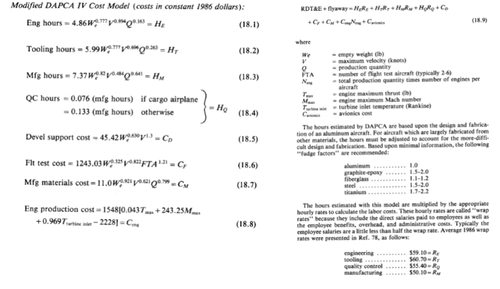
You can easily implement them into Excel or any spreadsheet program, then divide the RD/TE with the amount of aircrafts being produced plus prototype. That's how you got the "initial" batch cost. Later however you may want to introduce "production cost curve" This would be simpler, where the required variable is the learning curve constant (0.95 maybe for aircraft made using imported components) Then you could estimate the cost of future batch.
Word of caution however is to implement correction as the equations are for FY-86 USD. You have to correct the estimate with present day USD.
- Joined
- 29 November 2010
- Messages
- 1,772
- Reaction score
- 3,469

Korea, Indonesia set renegotiations for joint fighter jet development project
Korea and Indonesia are working on a new agreement for their joint fighter jet project, which has hit a snag following Indonesia's delay in paying hundreds of millions of dollars.
TLDR: Koreans sending delegation to Indonesia to demand answers on the status of their contribution
Indonesians want to reduce amount of contribution, and also want an option to pay via CN-235 planes rather than cash
also want more tech transfers
- Joined
- 11 February 2010
- Messages
- 1,641
- Reaction score
- 2,678

Korea, Indonesia set renegotiations for joint fighter jet development project
Korea and Indonesia are working on a new agreement for their joint fighter jet project, which has hit a snag following Indonesia's delay in paying hundreds of millions of dollars.www.koreatimes.co.kr
TLDR: Koreans sending delegation to Indonesia to demand answers on the status of their contribution
Indonesians want to reduce amount of contribution, and also want an option to pay via CN-235 planes rather than cash
also want more tech transfers
This is embarrassing but true. The butthurt back from 2013 hasnt healed.
We actually budgeted for KFX devs and plan to pay on time since 2012. The problem was that when the budget really got approved, there was that 2013 political matters in Korea (election and stuff) which slowed down the project and the budget ended up not being properly absorbed. This is what our treasury and bean counters doesnt like to see. As a result they slashed down the budget next year, worst that there begin voices deep down in our govs on KFX. There also apparently a loop holes in the MOU where delay in payments actually goes unpunished.
My biggest issue is why our govt rate themselves way too highly. Or maybe it's an ethiquette in diplomacy where one cant really talk straight about their real condition.
A Korean perspective on foreign buyer field maintenance (the interesting part start at 02:00):
View: https://youtu.be/4-O14C70Z8o
Not directly related but somewhat relevant:

 www.forbes.com
www.forbes.com
It would however seems obvious today that they go after a handful of Rafale at 400M€ the dozen...
Greek and Argentinan color being similar, it's even possible that Frenchs won't even notice...
Korea Aerospace Industries executive Martin Chun delivered the bad news in an Oct. 28 letter to the Argentine ambassador to South Korea. “The export of six major components produced by U.K. suppliers for FA-50 is subject to approval of U.K. government.”
The United Kingdom placed an arms embargo on Argentine following the ‘82 war. That embargo remains in effect. “It is our regret to inform you that the U.K. export license issue is not resolved to date,” Chun wrote.
And with that, the FA-50—just like the Gripen, F-16, Mirage F.1 and FC-1—is off the table for Argentina. It’s unclear where Buenos Aires might look next for its fighter needs, which grow more dire by the year.

No FA-50s For You! U.K. Bureaucrats Swat Down Argentine Fighter Plan
Budgetary problems, government infighting and, more recently, U.K. diplomatic maneuvering have combined to deprive Buenos Aires’ air force of new planes.
 www.forbes.com
www.forbes.com
It would however seems obvious today that they go after a handful of Rafale at 400M€ the dozen...
Greek and Argentinan color being similar, it's even possible that Frenchs won't even notice...
Last edited:
- Joined
- 29 November 2010
- Messages
- 1,772
- Reaction score
- 3,469
according to that link, the FC-1 is off the table? does it have UK sourced components?
- Joined
- 16 April 2008
- Messages
- 9,586
- Reaction score
- 14,415
according to that link, the FC-1 is off the table? does it have UK sourced components?
Probably different reasons. The FC-1 proposal was from a 2015 deal with then-President Kirchner. When she lost the election, that deal may have been tabled. Then FA-50 was selected. Now Kirchner is (sort of) back and the FA-50 is off, so it's conceivable they might revisit that. But the geopolitics of buying Chinese have shifted a lot in the last few years...
- Joined
- 29 November 2010
- Messages
- 1,772
- Reaction score
- 3,469

KF-X 공동개발 인도네시아, 분담금 6000억 ‘모르쇠’
한국형전투기(KF-X) 공동개발국인 인도네시아가 2016년 이후 지금까지 분담금을 제대로 납부한 적이 한 번도 없는 것으로 드러났다. 거액의 분담금을 연체한 인도네시아는 프랑스산 라팔 전투기 도입을 추진 중이다. 국회 국방위원회 소속 국민의힘 강대식 의원이 23일 방위사업청...
translation: Indonesia owes 600 billion won for KFX fees
about 550 million USD?
12000 Ibs. Ain't much as KF-X is intended to be assigned mostly on DCA missions alongside limited OCA duties and standoff IA/maritime surface attack in and around the Korean peninsula.How much fuel does it carry internally?
According to the studies conducted by DAPA (Defence Acquisition Program Administration) in 2019, EF-2000 has the data fusion ability of JDL level 0(Probably based off of information provided by EADS during F-X). Considering that Rafale has been developed around the same period with comparable technologies it wouldn't be far off to suggest that the Rafale has the same JDL level 0 data fusion ability.My friend, I think it will be sold well in the middle east to countries like the UAE which have very good relations with South Korea to replace Mirage 2000 and Block 60 in 10-15 years possibly and complement F-35.
do you think it will be superior to the late block F-16s and Eurofighter/Rafales?
KF-X is aimed for JDL level 1. Keep in mind that Rafale Standard F4 and Eurofighter Trance 4 is in development and thus Tranche 5 is being offered, I would say that the Eurocanards after these upgrades would not be far off of KF-X or could be superior.
MCs and avionics structure are based on integrated modular architecture just like every new 5th and 4.5th gen aircrafts but it seems to show more comparable level of integration to Pave Pillar structure on the F-22 rather than that of Pave Pace on F-35 (i.e. the difference between integration with compromise or fully integrated avionics). In fact, KF-X avionics structure is IMA-Federated hybrid, meaning there are some trade-offs even compared to Pave Pillar. This is due to several electronics operating with defined physical boundary instead of a software boundary(eg. OFP)
On HW level the radar and EW suite are top notch. Throughput of the radar is more than decent since it uses GaN technology. KAI and ADD have claimed that KF-X's EW antenna arrays are designed to be bigger than that of legacy 4.5th gen fighters in order to achieve greater jamming output power and also operate in bandwidths traditionally not covered by fighter SPJ suites. Even so, SW is probably more important for these specific avionics and this is what the Koreans would relatively lack on compared to the Europeans. It is hard to judge since the information on data accumulation and processing structure and techniques are harder to find and I personally would hold my judgement for that reason.
Another thing to consider is that Elta is helping out with testing and evaluation of the radar and SAAB is providing technical assistance and advise for algorithm designing. So they at least have two very sound partners/teachers.
The development of underlying technologies could be traced back to the early-mid 2000s, such as the FLCC, MC, AESA and so on. Some even have its roots dating back to the 90s so it wouldn't be a stretch to say that the Koreans were preparing for KF-X for at least a decade.
Last edited:
- Joined
- 11 February 2010
- Messages
- 1,641
- Reaction score
- 2,678
12000 Ibs. Ain't much as KF-X is intended to be assigned mostly on DCA missions alongside limited OCA duties and standoff IA/maritime surface attack in and around the Korean peninsula.How much fuel does it carry internally?
My friend, I think it will be sold well in the middle east to countries like the UAE which have very good relations with South Korea to replace Mirage 2000 and Block 60 in 10-15 years possibly and complement F-35.
do you think it will be superior to the late block F-16s and Eurofighter/Rafales?
On HW level the radar and EW suite are top notch as well. Throughput of the radar is more than decent (I've once read the calculation which claims that the AESA on KF-X has the similar output compared to that of F-35 but have forgotten the source. Take this claim with a grain of salt but individual TRM on the Korean AESA has more output power than that of F-35 iirc so it might be true) and KAI and ADD have claimed that KF-X's EW antenna arrays are designed to be bigger than that of legacy 4.5th gen fighters in order to achieve greater jamming output power. Even so, SW is probably more important for these specic avionics and this is what the Koreans would relatively lack on compared to the Europeans. Given that unlike the HW there ain't much infos given on the side of SWs I would hold my exact judgement.
That brings question on duty cycle. Like one can make 100 Watt peak power TRM.. But what determines range and power aperture performance of a Radar is the Average power (Emitted power in function of time) or peak power multiplied by duty cycle.
Like 12000 Lbs of fuel may correspond to cooling capacity of 13.9 KW available for Radar (Total cooling capacity is approximately 35 KW) This, at frequency of 10 GHz and PAE of 33% (Typical of Class A Amplifier) Would constrain the average emitted power for 1088 TRM to 3.3 KW maximum.
The module may have 30 Watt of peak power, but it might only operates at 10% duty cycle. It wont put as many pulses or power compared to anything having greater duty cycle. Might not even match AN/APG-79 or AN/APG-82. Seeing that the fighters bearing them have greater cooling capacity.
Great point right there but KF-X doesn't use it's fuel but a separate cooling liquid (PAO) and is designed with adequate cooling capacity in mind. Might be the reason they are using 20W TRM instead of the 30W model they already have.12000 Ibs. Ain't much as KF-X is intended to be assigned mostly on DCA missions alongside limited OCA duties and standoff IA/maritime surface attack in and around the Korean peninsula.How much fuel does it carry internally?
My friend, I think it will be sold well in the middle east to countries like the UAE which have very good relations with South Korea to replace Mirage 2000 and Block 60 in 10-15 years possibly and complement F-35.
do you think it will be superior to the late block F-16s and Eurofighter/Rafales?
On HW level the radar and EW suite are top notch as well. Throughput of the radar is more than decent (I've once read the calculation which claims that the AESA on KF-X has the similar output compared to that of F-35 but have forgotten the source. Take this claim with a grain of salt but individual TRM on the Korean AESA has more output power than that of F-35 iirc so it might be true) and KAI and ADD have claimed that KF-X's EW antenna arrays are designed to be bigger than that of legacy 4.5th gen fighters in order to achieve greater jamming output power. Even so, SW is probably more important for these specic avionics and this is what the Koreans would relatively lack on compared to the Europeans. Given that unlike the HW there ain't much infos given on the side of SWs I would hold my exact judgement.
That brings question on duty cycle. Like one can make 100 Watt peak power TRM.. But what determines range and power aperture performance of a Radar is the Average power (Emitted power in function of time) or peak power multiplied by duty cycle.
Like 12000 Lbs of fuel may correspond to cooling capacity of 13.9 KW available for Radar (Total cooling capacity is approximately 35 KW) This, at frequency of 10 GHz and PAE of 33% (Typical of Class A Amplifier) Would constrain the average emitted power for 1088 TRM to 3.3 KW maximum.
The module may have 30 Watt of peak power, but it might only operates at 10% duty cycle. It wont put as many pulses or power compared to anything having greater duty cycle. Might not even match AN/APG-79 or AN/APG-82. Seeing that the fighters bearing them have greater cooling capacity.
Last edited:
- Joined
- 11 February 2010
- Messages
- 1,641
- Reaction score
- 2,678
PAO is the intermediate medium which will dump the heat to somewhere (as clearly you cant just pump fuel into the array) Even APG-79 use PAO and it dumps the heat to fuel.Great point right there but KF-X doesn't use it's fuel but a separate cooling liquid (PAO) and is designed with adequate cooling capacity in mind. Might be the reason they are using 20W TRM instead of the 30W model they already have.12000 Ibs. Ain't much as KF-X is intended to be assigned mostly on DCA missions alongside limited OCA duties and standoff IA/maritime surface attack in and around the Korean peninsula.How much fuel does it carry internally?
My friend, I think it will be sold well in the middle east to countries like the UAE which have very good relations with South Korea to replace Mirage 2000 and Block 60 in 10-15 years possibly and complement F-35.
do you think it will be superior to the late block F-16s and Eurofighter/Rafales?
On HW level the radar and EW suite are top notch as well. Throughput of the radar is more than decent (I've once read the calculation which claims that the AESA on KF-X has the similar output compared to that of F-35 but have forgotten the source. Take this claim with a grain of salt but individual TRM on the Korean AESA has more output power than that of F-35 iirc so it might be true) and KAI and ADD have claimed that KF-X's EW antenna arrays are designed to be bigger than that of legacy 4.5th gen fighters in order to achieve greater jamming output power. Even so, SW is probably more important for these specic avionics and this is what the Koreans would relatively lack on compared to the Europeans. Given that unlike the HW there ain't much infos given on the side of SWs I would hold my exact judgement.
That brings question on duty cycle. Like one can make 100 Watt peak power TRM.. But what determines range and power aperture performance of a Radar is the Average power (Emitted power in function of time) or peak power multiplied by duty cycle.
Like 12000 Lbs of fuel may correspond to cooling capacity of 13.9 KW available for Radar (Total cooling capacity is approximately 35 KW) This, at frequency of 10 GHz and PAE of 33% (Typical of Class A Amplifier) Would constrain the average emitted power for 1088 TRM to 3.3 KW maximum.
The module may have 30 Watt of peak power, but it might only operates at 10% duty cycle. It wont put as many pulses or power compared to anything having greater duty cycle. Might not even match AN/APG-79 or AN/APG-82. Seeing that the fighters bearing them have greater cooling capacity.
Oh I've mistaken what you mean(pumping the fuel into array thing) and thought you were suggesting such. Well that besides, KF-X doesn't dump the heat into the fuel but uses radiators connected to the ECS to dump heat into the air that came in via ram air intake. The radiator itself's not a flat panel but looks rather like a cooling box (don't really know how to put it) to be able to air-cool all that heat.PAO is the intermediate medium which will dump the heat to somewhere (as clearly you cant just pump fuel into the array) Even APG-79 use PAO and it dumps the heat to fuel.
- Joined
- 2 August 2006
- Messages
- 3,254
- Reaction score
- 1,524
That's what we call a heat exchanger. Thanks for the info.The radiator itself's not a flat panel but looks rather like a cooling box (don't really know how to put it) to be able to air-cool all that heat.
- Joined
- 2 January 2006
- Messages
- 3,816
- Reaction score
- 5,013
At least I haven't seen this:

 m.blog.naver.com
m.blog.naver.com

[KAI 업그레이드] 조립오차 ‘제로’에 도전한다 동체자동결합시스템 FASS(Fuselage Automated Splice System)
최종조립에 돌입하는 항공기의 주요 부품들의 중량은 대단히 무겁다. 주로 기수와 중앙동체, 그리고 후방동...
 m.blog.naver.com
m.blog.naver.com
Mach42
I really should change my personal text
- Joined
- 10 February 2013
- Messages
- 90
- Reaction score
- 87
Separate photograph (of infuriating small size) realised via an online "article". https://www.sedaily.com/NewsVIew/22H43GZJR8At least I haven't seen this:

[KAI 업그레이드] 조립오차 ‘제로’에 도전한다 동체자동결합시스템 FASS(Fuselage Automated Splice System)
최종조립에 돌입하는 항공기의 주요 부품들의 중량은 대단히 무겁다. 주로 기수와 중앙동체, 그리고 후방동...m.blog.naver.com

I spy further sub-assemblies on the left in the background on the left and what seems to be the flag of Indonesia on the wall at the right on the image too.
Frogfigther
ACCESS: Restricted
- Joined
- 30 August 2020
- Messages
- 45
- Reaction score
- 169
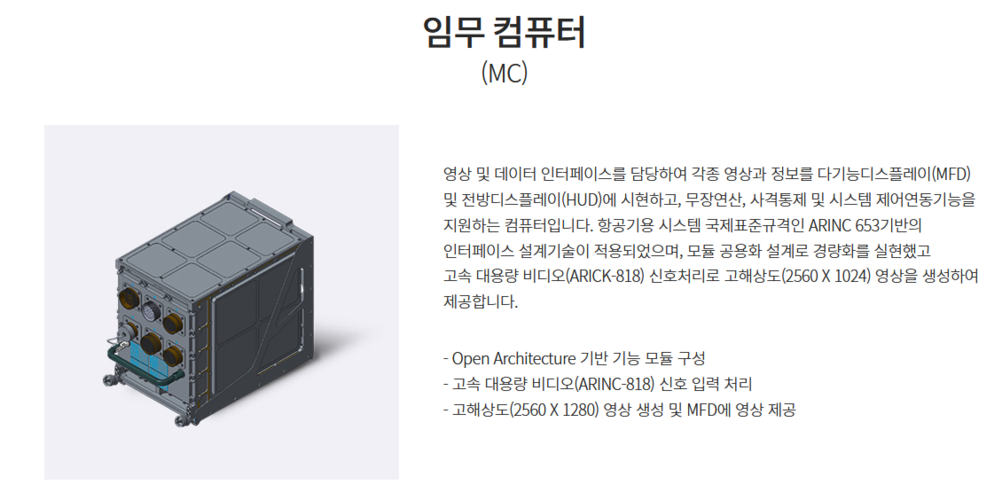
Mission Computer
- Interface Video and Data, and Display HUD & MFD
- Support Fire Control, Arm Management, and System Conrtol Interlocking
- ARINC653 based interface
- ARICK-818 Video Signal Processing for LAD; Resolution 2560x1024
- Open Architecture
- Generate Videos for LAD and MFDs
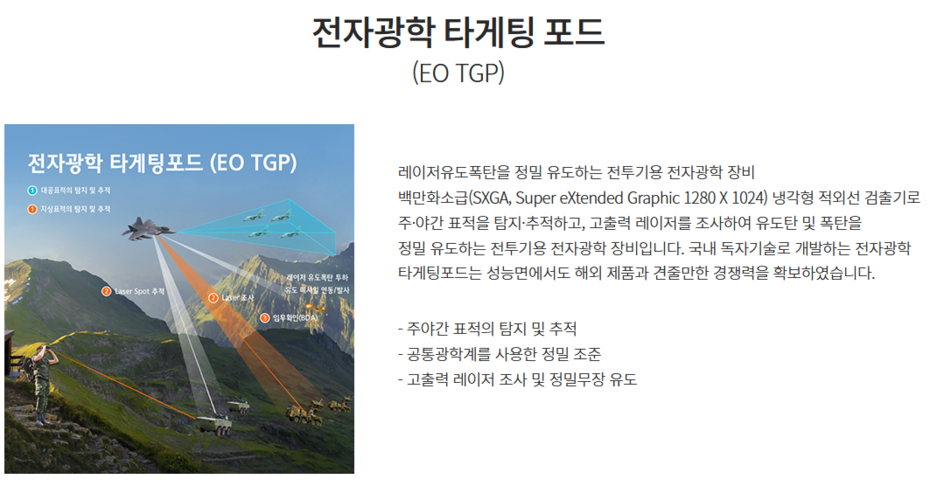
EOTGP
- SXGA(1280x1024) Resolution IR Sensor
- High Power Laser for LGB
- Common Optical System
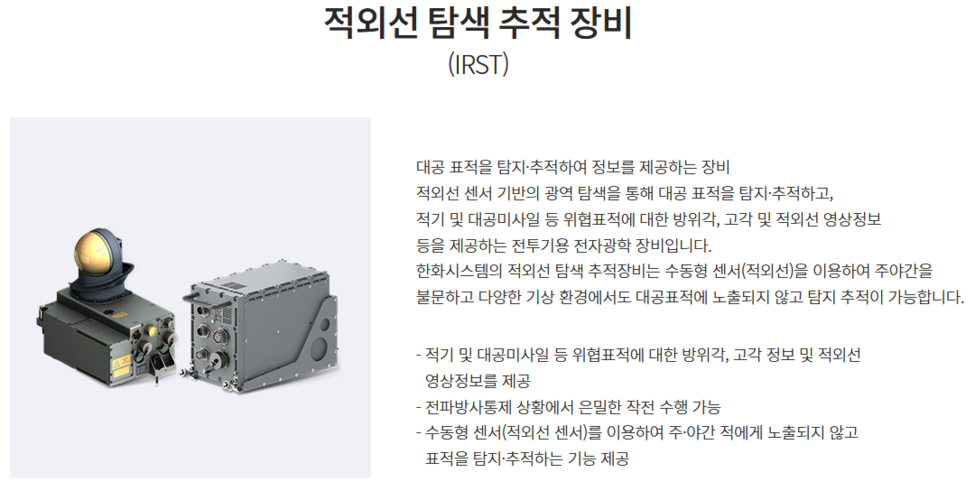
IRST
- Leonardo Skyward based
- Detect/Track Aircrafts and Missiles
- Generate IR image, Angle information for the aircraft
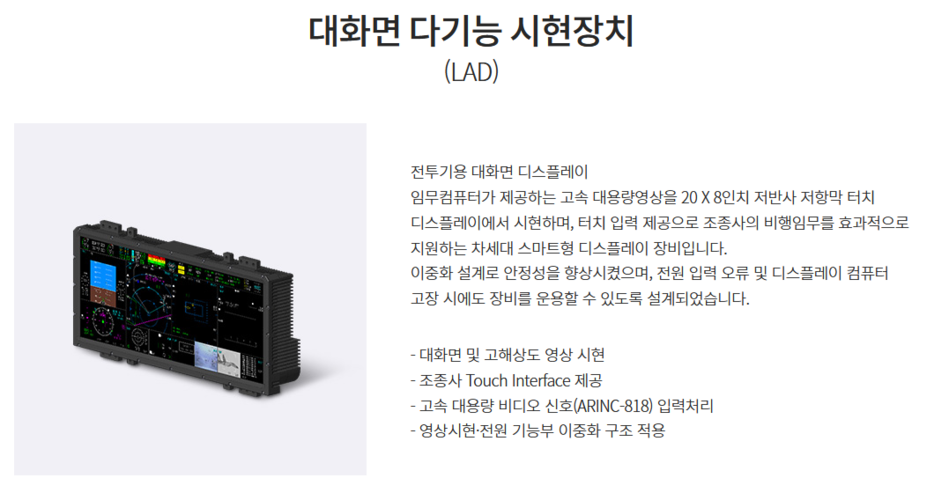
LAD
- 20'' X 8'' Resistive Touchscreen
- ARINC-818 Interface
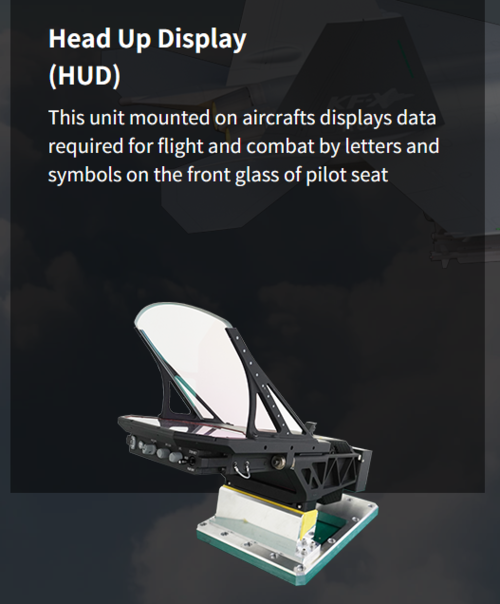
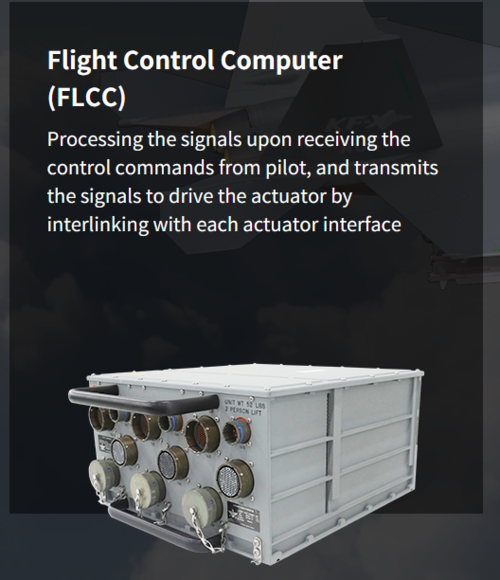
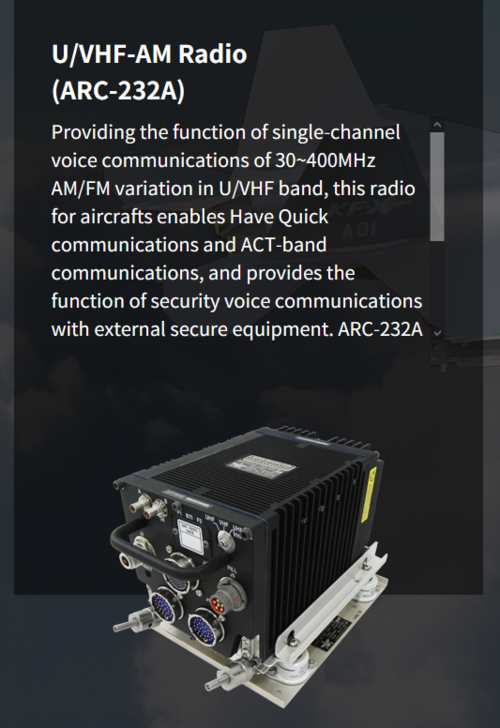
BAE LiteHUD & LIG Nex1 FLCC & BAE ARC-232A SDR
Source
차세대 한국형 전투기 | 항공 | 우주·항공 | Defense | 한화시스템
Attachments
Last edited:

